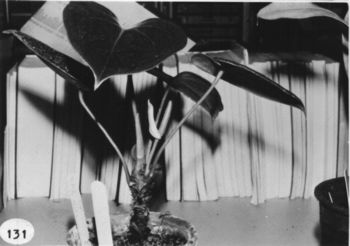




Anthurium roseospadix Croat, sp. nov.
TYPE: Panama. Panama: Cerro Jefe, al summit, ca. 1,000 m, 15.4 mi. from Pan-American Hwy., 9°12'N, 79°22'W, Croat 49091 (MO 2737325, holotype; CAS, DUKE, F, K, M, NY, PMA, US, VEN, isotypes; Live at MO).
Planta epiphytica aut interdum terrestris; caudex us-que 70 cm longus; persistens intactum, ultimo decidu-um; petiolus subteres, 12-37 cm longus, anguste com-planatus adaxiale; lamina modice coriacea, ovata ad ovato-triangulata, basi leviter aut profunde cordala, 12-28 cm longa, 9-22 cm lata; inflorescentia erecta; pedunculus teres, 7.5-18 cm longus; spatha subcori-acea, viridulo-alba interdum tincta rosea, ovato-elliptica ad oblongo-elliptica, 6-13 cm longa, 1.7-3 cm lata; spadix violaceo purpureus, 4-7 cm longus; baccae obovoido-ellipsoideae, basi albidae, apice brunneolae.
Epiphyte or less frequently terrestrial, rooted in deep debris, to 125 cm tall; stem moderately elongate, sometimes to 70 cm long, 1-2 cm diam.; internodes short near apex, sometimes more elongate in lower portion; leaf scars usually obscured by cataphylls, to 1 cm wide; roots moderately few, greenish, scattered along stem, ca. 4 mm diam.; cataphylls green, coriaceous, weakly cuspidate at apex, drying brown, persisting intact, ultimately deciduous.
LEAVES spreading; petioles subterete, 12-37 cm long, 4-5 mm diam., narrowly flattened adaxially; geniculum 1.5-2 cm long, shaped like petiole or obscurely sulcate; blades moderately thick, ovate to ovate-triangular, abruptly acuminate at apex, shallowly or prominently lobed at base, 12-28 cm long, 9-22 cm wide, broadest at point of petiole attachment; anterior lobe 10.5-21 cm long, the margins straight to convex; posterior lobes 1.5-6.5 cm long; sinus arcuate to parabolic, rounded at apex; both surfaces semiglossy to glossy; midrib raised above, acutely raised below; basal veins 3-6 pairs, the first and sometimes the second free to the base, those remaining coalesced 0.5-1 cm, raised above and below; posterior rib absent or more or less straight, naked, weakly turned up along outer margin; primary lateral veins 4÷8 per side, relatively inconspicuous, weakly sunken, straight or weakly arching near collective vein; lesser veins obscure, more conspicuous on drying; collective vein arising from second or third basal vein, loop-connecting the primary lateral veins, 2-8 mm from margin.
INFLORESCENCE erect; peduncle terete, 7.5-18 cm long, 4-5 mm diam., ca. one-half as long as petioles; spathe subcoriaceous, greenish white sometimes tinged pinkish (B & K Yellow-green 9/10), ovate elliptic to oblong-elliptic, 6-13 cm long, 1.7-3 cm wide. broadest at the base, acuminate at apex, truncate to rounded at base; spadix violet purple (B & K Purple 3/10-4/5), scarcely tapered at apex, 4-7 cm long, 6-9 mm diam. at base, 3-6 mm diam. near apex; flowers rhombic to 4-lobed, 2-2.4 mm long, 2-3 mm wide, the sides jaggedly sigmoid, 6-7 flowers visible in the principal spiral, 5-8 flowers visible in the alternate spiral; tepals glossy, lateral tepals 1-1.2 mm wide, the inner margins concave, more or less angular; pistils flat to weakly mounded, white, glossy; stigmas linear, ca. 0.3 mm long, dry when stamens emerge; stamens emerging rapidly beginning at the base, anthers not exposed, pollen exuding from between pistil and tepals, held above and obscuring pistil; pollen white.
INFRUCTESCENCE with obovoid-ellipsoid berries, ca. 8.5 mm long, white in lower portion, brownish near apex, mammilliform at apex; mesocarp gelatinous, transparent; seeds tan, ca. 5 mm long, 2 mm diam. Fig. 131.
Anthurium roseospadixis endemic to Panama. It was first collected by Dr. Edwin Tyson in January 1966, then again in February and July of the same year. Most collections are from the vicinity of Cerro Jefe in premontane rain forest, but the species has also been collected in the Canal Zone along the Caribbean at nearly sea level in what was probably premontane wet forest and possibly even tropical wet forest. Despite this drastic difference in elevation and life zone, the collection (Mori & Kallunki 2738) differs in no way from those on Cerro Jefe. The species is a member of section Calomystrium and is distinguished by its coriaceous ovate to ovate-triangular cordate blade, its intact persistent cataphylls, its relatively short-pedunculate inflorescence, its thick greenish white, narrowly ovate-elliptic spathe, and especially by its stubby, slightly tapered violet purple spadix. It may be confused with Anthurium erythrostachyum, another Panamanian member of section Calomystrium that has a similarly colored spadix, but the latter differs in that it has a greenish, cuspidate-acuminate spathe and thinner, typically more triangular-ovate blades. In addition, it more frequently has stems with elongate internodes that dry a characteristic pale reddish brown. In contrast, mature stems of A. roseospadix commonly have short internodes.

Map of Mesoamerican specimens with coordinates
Panama Darien: 1250-1500 m, 8.04.30N 77.14.00W, 20-26 Oct. 1987, Greg
de Nevers, H. Cuadros, B. Hammel & H. Herrera 8406 (MO).
Panama Darien: 1250-1500 m, 8.04.30N 77.14.00W, 20-26 Oct. 1987, Greg
de Nevers, H. Cuadros, B. Hammel & H. Herrera 8500 (MO).
Panama Darien: 1300-1500m, 8.09.5N 77.15.0W, 27 Oct 1987, B. Hammel
G. de Nevers & H. Herrera 16568 (MO).
Panama Panamá: Cerro Jefe, 850-900 m, 9.15N 79.30W, 12 July 1986, McDonagh
et al. 63 (BM).
Panama Panamá: 850 m, 9.14N 79.22W, 8 July 1987, Thomas B. Croat 67056
(MO).
Panama Panamá: 850-900 m, 9.15N 79.30W, 3 Nov. 1985, Gordon McPherson
7431 (MO).
Panama Panamá: 800-850 m, 9.20N 79.15W, 20 Nov. 1985, Gordon McPherson
7519 (MO).
Panama Panamá: 950 m, 9.15N 79.30W, 11 Oct. 1985, Gordon McPherson
7126 (MO).
Panama Panamá: 850-900 m, 9.15N 79.30W, 3 Nov. 1985, Gordon McPherson
7416 (MO).
Panama Panamá: 900 m, 9.14N 79.23W, 20 Jan. 1984, H.W. Churchill 4292
(MO).
Panama Panamá: 09.15N 79.30W, 17 June 1994, Thomas B. Croat & Guanghua
Zhu 76214 (CM, MO).
Panama Panamá: 770 m, 09.15N 79.29W, 4 July 1994, Thomas B. Croat &
Guanghua Zhu 76615 (CM, MO, PMA).